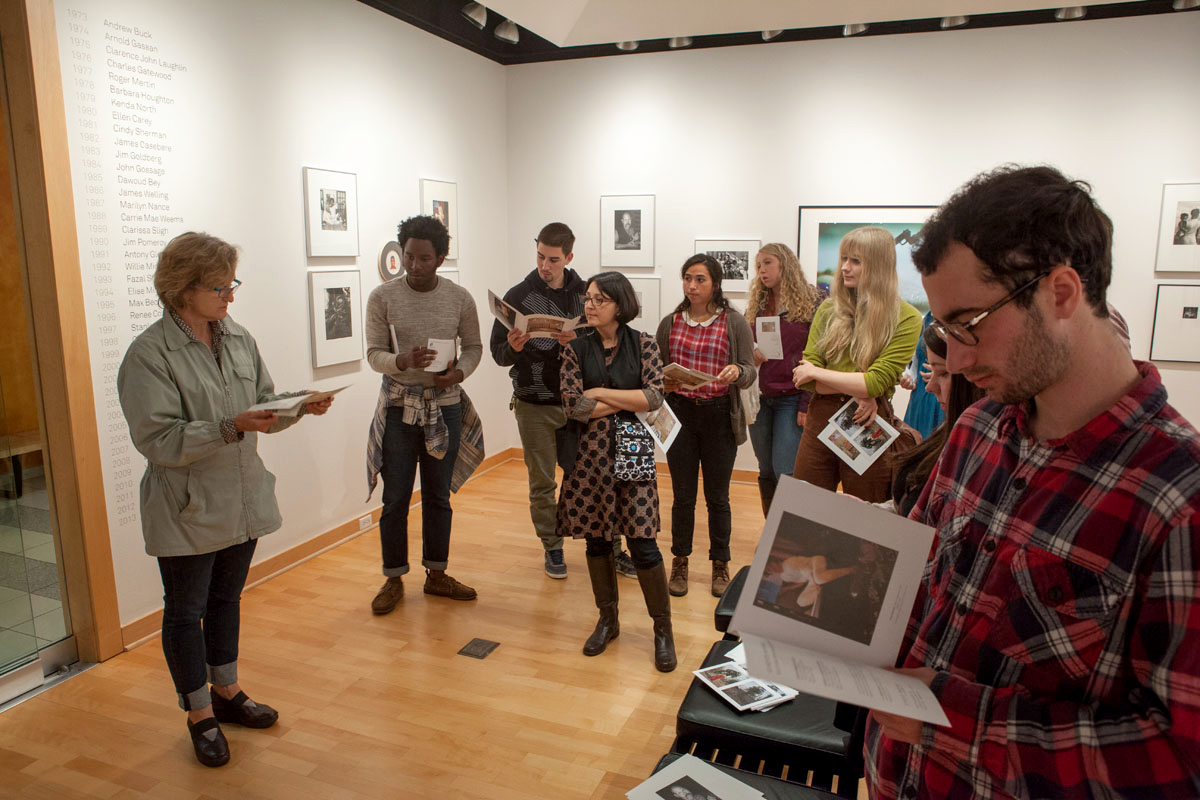
On Feb. 1 of next semester, the Wellin Museum of Art will showcase two very special exhibitions side-by-side: In Context: The Portrait in Contemporary Photographic Practice, and Refocusing the Lens: Pranlal Patel’s Photographs of Women at Work in Ahmedabad. What makes these exhibitions so special is that they will represent the culmination of two semester-long interdisciplinary courses that have been co-taught by Assistant Professor of Art Robert Knight and Associate Professor of History Lisa Trivedi.
Both of the two fall semester courses were broken down into three parts. Students from Professor Knight's course, Art 370 Curating the Archive, and Professor Trivedi’s course, History 370 Topics in South Asian History: Women, Labor and Photography in India, came together for the first and second parts of the course, and then pursued their specific topics of interest independently for the third part of the course.
The first part focused on the history and theory of documentary photography. The second concentrated on the process of museum curation and how to create a curatorial statement. It was during this time that the two classes took a field trip to the Eastman Museum in Rochester, and began designing their own exhibition-layout proposals based on what they had learned previously about artist selection, exhibition layout and design, and development of the catalogue, wall text and other multi-media materials.
For the third part of the course, which took place at the end of the fall semester, Knight’s students have been creating art in a variety of media including photography, sculpture, painting and audio to showcase in the spring exhibitions. Concurrently, Trivedi’s students have been working towards creating an exhibition portfolio, complete with a layout of the Patel exhibition, wall text, label materials and podcasts.
Knight and Trivedi jointly conceived of the idea for this class nearly two years ago during the 2011-2012 academic year. In the true spirit of a liberal arts education, the intention of this class was to provide students with a unique experiential learning opportunity unlike that of the typical lecture-style class.
Knight explained, “This class provides a highly unusual educational opportunity, which combines aspects of a traditional classroom experience with something more akin to a museum internship. What I found most inspiring about the course was the opportunity to include the students in the actual exhibition process. As far as I know,” he said, “nothing quite like this has been done at Hamilton before.”
Trivedi added that she hopes the course will help students to develop practical problem-solving skills. “I have tried to be transparent about each stage in our process this fall,” she said. “Students have witnessed discussions between Tracy Adler and me about the selection of materials for the exhibition. They have been apprised of unexpected challenges and the solutions that we have come up with. And, they have had access to my work for the catalogue that will accompany the exhibition, including an interview with the photographer and a catalogue essay,” Trivedi explained.
For Sean Henry-Smith ’15, who is enrolled in the Art 370 course and hopes to pursue a career in curating down the road, this class provided him with an invaluable career-related experience. “I can already say I’ve gotten more from this course than I anticipated, and there is still much more to learn,” he said. “It has sparked an interest in semiotics and structuralism, and has truly forced me to evaluate my role as a photographer. I am nowhere near proficient,” said Smith, “but I now have a working knowledge of Google SketchUp, and as trite it may sound, I have learned the importance of spacing...It is all incredibly exciting, and has only furthered my interest in the field.”
Even students who are not trying to make a career out of museum curation have taken valuable knowledge and a new perspective away from the course. Charlotte Van Dercook ’14, who is enrolled in the History 370 course, remarked, “My favorite part of the course has been critically synthesizing the assigned historical and theoretical texts and then producing writing for both exhibitions…Through guest speakers including Tracy Adler, the Wellin director, [and] Professor Helmer, who spoke about how to translate written work to spoken communication for podcasts, this class has covered many different topic that have advanced my understanding of exhibition development and production,” said Van Dercook.
Morgan Lane ’16, who is also enrolled in History 370, added, “I’ve definitely come to realize that photography has an immense power over its audience and can be used to inspire, motivate, inform and even surprise viewers of all different backgrounds and circumstances. Although the Patel exhibit we are displaying is all documentary photography from 1930s India, the photographs still have profound effect on viewers in upstate New York in 2013.”
Notably, photography icon Pranlal Patel himself will visit the exhibition of his work during the spring semester. As he is one of the last surviving photographers to have documented important Indian leaders like Gandhi and Nehru in the 1930's and 40's, the students are excited to show him the work they have done over the course of the semester.
With interdisciplinary learning continuing to play an ever increasing role in what it means to have a Hamilton education, there is no doubt that this class will serve as a model for future exhibition development in Wellin in the future.
